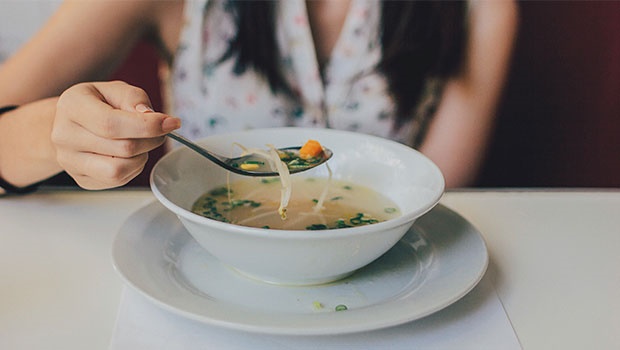
The eating disorder it's trendy to have...
If you’ve read about the beginnings of my health and fitness journey, you’ll know that this strange new world was life-changing for me.
After years of crash dieting and yo-yo weight loss and gain, I’d finally figured out what my body wanted and needed to be the strongest, healthiest, fittest version of myself – or so I thought.
After a few months of following Kayla Itsine's BBG programme, I was finally brave enough to dabble in other fitness classes, weight lifting, spinning – and I was totally addicted.
And then it all got a bit weird…
Seeing my body change was out of this world – and I wanted more. Having previously (loosely) followed Instagram sensation Kayla’s healthy, sensible HELP eating guide, I decided I wanted to “get healthier” (read: skinnier).
Since I couldn’t really exercise more than I already was – six days a week, sometimes twice a day – I decided I’d have to change my diet.
Calories out *must* exceed calories in right? I started meticulously tracking every single thing that went into my mouth. I even measure out the milk I used in my coffee...
I realised I was eating about 1 600 calories a day. Surely that was too much? Maybe just a little less… I started decreasing my intake. 1500… 1200… no more than 1000 – only ‘clean’ foods, of course – and those stubborn last few kgs slipped off.
I had done it! I’d finally mastered my body. I was going to train and calorie-count myself skinny come hell or high water! Eventually, I found the perfect formula. I was losing about a kg a week from my already slim frame. My goal weight had been 52 kg – already pretty low, even for my 1,6 m height. But when I hit that, I wasn’t proud – I felt unfinished. I wanted more. Perhaps I could get to 49 kg..? Give myself a bit of a buffer..?
Hello, orthorexia!
I stopped eating anything my family or friends cooked for me. Had they used a reasonable portion of olive oil in that healthy dish they were making especially to accommodate me? Packet sauce? Non-complex carbs? WTF!
Eating out became a no-go too – it made me anxious. How could I possibly know what kind of cheese was in that salad? How could I accurately track the calories if I couldn’t take my trusty kitchen scale with me and immediately input the data into MyFitnessPal?
I remember once nearly crying when I went out for dinner with my family. The waitress had ignored my request for “dressing on the side” of my teeny tiny salad. I rudely told her to take it back and get the chef to make a new one. “And don’t just rinse it off,” I said snarkily, “I’ll know.”
My mom, who has always been the person closest to me in the whole world, tried to reason with me that night. “Aren’t you going a bit too far, love?” she said gently. “You’ve lost more weight that you originally set out to… and you’re very thin now. Maybe you can ease up a bit?”
I flew off the handle at her. What did she know? I was eating clean, I was eating healthy – I had spent hours pouring over books, sites, blogs, #cleaneating Insta-posts – I had done the research!
Deep down, I was petrified. If I let the salad dressing slip, even just this one time, what else would go? I’d lose control – I’d gain all the weight back! I wasn’t going to be one of those girls.
So I stopped going home. My mom’s worried glances were too unnerving. I made excuses every time my friends tried to get me to go out, to come over.
Eventually, they stopped calling.
It was about 50 kg when my period stopped. I pushed away the idea it had anything to do with my training or calorie-counting. My BMI was still within the normal range – it’s not like I was bulimic or anorexic. This was the healthiest I’d ever been!
A doctor confirmed my theory. She diagnosed me with Polycystic Ovarian Syndrome – even though I had absolutely no other symptoms. Her advice was to go on the pill, which of course, I refused to do – it might make me gain weight! And who needed periods anyway?
The turning point
Then, several weeks later, my world came crashing down around me. Well, technically I came crashing down… I fell off the patio while house-sitting in Cape Town’s southern suburbs (it’s reeeeally dark out there) and landed at an awkward angle on my left leg.
A trip to the emergency room and a specialist later, I had my diagnosis – I had torn three (three!) different ligaments, torn both menisci and damaged my knee-cap. There was nothing for it – I’d need surgery. And I wouldn’t walk – let alone workout – for months…
I was devastated – but not for my poor broken knee. Because I was going to get “fat again”. I sunk into a miserable depression, resigning myself to my fate. If this was what life was going to throw at me, then what the hell! I was letting go! Bring me all the cookies!
I basically lived on rusks and sat on my bum for a month.
And you know what? It wasn’t so bad.
Also, I had a lot of time to think…
Ten weeks after my surgery, I was hobbling along on crutches (feeling desperately sorry for myself, of course). I was at a pretty cool conference for work, and it was my birthday. And I got the most unexpectedly wonderful gift.
My period.
Exactly two months and 29 days after my fall, it came back. And the relief I felt left me taken aback. I didn’t have PCOS… I had no idea how much that (incorrect) diagnosis had panicked me. I might not battle to have kids. There was nothing wrong with my body…
A visit to the doctor – and some blood tests I insisted upon – confirmed it. I remember the gynaecologist’s bemused expression when she said, “You were basically your own science experiment. You weren’t technically underweight, but you just didn’t have enough for your body to produce oestrogen for you to ovulate,” she explained. She even asked if she could use me as a case study at a conference she was speaking at…
Baby steps
So, it’s officially been a year since I started walking again – and I’m amazed at how well my body has healed. I’m even back at the gym, starting BBG from scratch! Of course, those jump lunges are a no-go now… But that’s OK.
And yep, I put on weight – I levelled out at about 58 kg. Weirdly, I’ve gotten so many compliments since. It’s strange how many people thought I looked sick when I was at my skinniest – but didn’t have the guts to tell me until I was “normal” again.
The eating? Well, I’m working on it… I’ve rediscovered my love of food (and pizza omg) – which you’ll know if you follow me on Instagram (#sorrynotsorry). I go out to eat now without having heart palpitations, and I (mostly) happily eat whatever’s put in front of me – and try not to think too much about the calorie content.
Of course, there’s still a part of me that looks in the mirror and longs for the teeny tiny waist I painstakingly carved out all those months ago. And I have to take a step back and remind myself that right now my body is healthier than it was then (my period has come every month like clockwork!) – and so is my mind.
All that stress, anxiety… the sleepless nights I’d spent beating myself up over a ridiculous number on a scale, a stupid size on a label… the relationships I almost ruined…
Confession: every time I need to remind myself of how much more beautiful my life is when I’m not totally, 100% in control, I use this little trick…
Pizza.
What is orthorexia?
Simply put, orthorexia nervosa, is an “unhealthy obsession” with healthy eating. According to nationaleatingdisorders.org, the term literally means “fixation on righteous eating.”
“Orthorexia starts out as an innocent attempt to eat more healthfully, but orthorexics become fixated on food quality and purity,” Dr Karin Kratina writes for the site. “They become consumed with what and how much to eat, and how to deal with ‘slip-ups’.”
While it’s not technically classified as a clinical diagnosis, the idea has gained plenty of traction lately. One of the first to speak out about their struggle with orthorexia was super-popular health food blogger Jordan Younger. She got candid about her battle with the disease, sharing her recovery journey with her almost 180 000 followers.
“The unhealthy habits that I developed over roughly a two-year period are ingrained into my body and my mind, and it’s very challenging to begin unwinding from them,” she wrote on her blog.
“I am still of the mentality that if I eat a large meal, or even a full meal for that matter, that I should pretty much ‘fast’ for the next several meals to balance it back out.”
There’s no consensus in the psychiatric community about whether orthorexia should be considered an eating disorder. Some scholars believe it’s pretty much an anorexia spin-off. But Dr Thomas Dunn of the University of Northern Colorado, one of the few doctors to have written for peer-reviewed journals on the issue, believes it should be a separate diagnosis.
“People with anorexia restrict their intake by following healthy diet fads to be thin,” he said, according to The Guardian. “People with orthorexia restrict their intake by following a healthy diet to be healthy.”
Which is a hell of a conundrum, no?
– Kirsti Buick is a writer at YOU Magazine and a health and wellness blogger




 Publications
Publications
 Partners
Partners
















